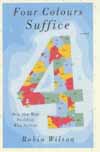'Four Colours Suffice'

Four Colours Suffice
The Four Colour Theorem - the statement that four colours suffice to fill in any map so that neighbouring countries are always coloured differently - has had a long and controversial history. It was first conjectured 150 years ago, and finally (and infamously) proved in 1976 with much of the work done by a computer. The published proof relied on checking 1432 special cases, which took more than 1,000 hours of computer time. Reactions to the news that the theorem had succumbed to this brute force attack varied from excitement to scepticism, but with mostly disappointment on the way. There was a widespread feeling that this "proof" was no proof at all.
Robin Wilson's book is a clear and well-written description of the history of the theorem; the people who worked on it, the mathematics they invented in their attempts to solve it, and the controversy that followed when it was finally proved. It is also that rarity - a book where mathematics is actually done in front of the reader, and which is also widely intelligible to a lay audience.
With elements of history and biography, and very well illustrated - of course essential, given the subject matter - Wilson takes the reader, step by step, through the proof of the theorem, scrupulously attributing the many and varied people who contributed to the eventual proof. These included, surprisingly, the French novelist and poet Paul Valèry. Even Euler spent some time on it, convinced that the only reason it had withstood for so long was that noone really good had worked on it!
The final chapter examines a question that had previously been of more interest to philosophers than working mathematicians, namely, "what is a proof?" With the spectacular advent of computer-aided proof, this question suddenly became controversial rather than academic, and is still the subject of heated debate.
The story of the Four Colour Theorem has some parallels with Fermat's Last Theorem. Neither theorem is in itself terribly important, but much of the work motivated by attempts to solve them has been immensely fruitful. In the case of the Four Colour Theorem, this includes the important subjects of graph theory and the study of networks, and much recent work on computer algorithms. Both were conjectured long ago, and withstood much effort and many false proofs before finally giving way before determined onslaughts. Where they differ is in the manner of proof; in the case of Fermat's Last Theorem, the "onslaught" was Andrew Wiles' solitary tour-de-force, in that of the Four Colour Theorem, it was a computer's brute force.
It is not surprising people were suspicious when the theorem was finally proved - not only was the proof essentially uncheckable, but the history of the theorem had been one of trial and error. That history is ably described in this pacy and well-written book, and the reader can expect to learn quite a bit about mathematical proof along the way.
- Book details:
- Four Colours Suffice: How the Map Problem Was Solved
- Robin Wilson
- hardback - 288 pages (2002)
- Allen Lane The Penguin Press
- ISBN: 0713996706